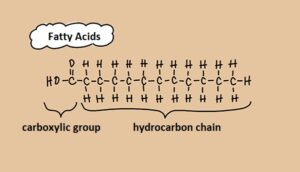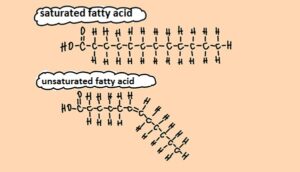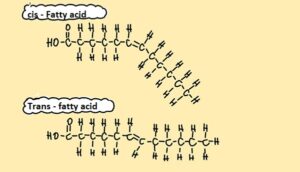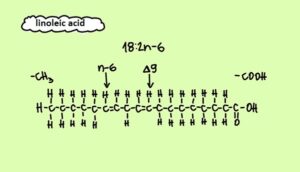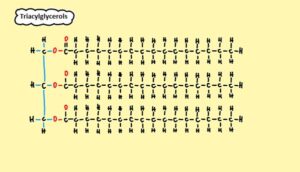Types of Fats? In the field of nutrition, when we talk about fats, triglycerides and fatty acids are most often referred to, but behind the concept of “fat” is much more information. Fats belong to a class of chemicals called lipids. Their name is of Greek origin – lipos, which means fat. Although lipids are classified as a very large set of substances, the basic and most important ones we need to know are several. Lipids are divided into three main categories, depending on their structure and origin:
Fatty acids, in turn, are divided into 2 main types:
-
saturated;
-
unsaturated.
Whether a fatty acid is saturated or not is determined by whether the hydrocarbon chain is composed entirely of single covalent bonds or contains double ones.
- monounsaturated – contain one double covalent bond;
- polyunsaturated – contain two or more double covalent bonds.
The double covalent bonds in unsaturated fatty acids are important because they have the potential to form well-known trans fats, which have been shown to be harmful to health. Although most double covalent bonds of fatty acids are in the standard cis position, in some foods trans naturally occur, but to a much lesser extent. The danger of trans fatty acids comes mainly from the process of (partial) hydrogenation, most often used in the food industry to harden vegetable oils. Making the food product margarine is an example of such a process.
Fatty acids are also classified as:
- essential (vital);
- non-essential (non-vital).
Unlike the other major energy source – carbohydrates, some fatty acids are essential for the proper functioning of the body. Due to the lack of the enzymes delta-12 and delta-15 desaturase, essential fatty acids cannot be synthesized by our body and we must get them through food. Lack of them can lead to various health problems.
The two main essential fatty acids are:
- linoleic acid (18: 2 n-6);
- alpha-linolenic acid (18: 3 n-3).
If you are wondering what is written in parentheses – this is one of the systems for abbreviating the chemical structure of various fatty acids. The designation contains information about the length of the chain of atoms and the number and position of double covalent bonds.
Nomenclature of fatty acids
There are two main systems for fatty acid notation. Let’s look at what the chemical structure of linoleic acid means in both.
Delta notation system
The designation of linoleic acid in the delta system is 18: 2 ∆9.12.
- The number before the colon, 18, indicates the number of carbon atoms in the chain;
- The number after the colon, 2, means the number of double covalent bonds;
- The numbers after the delta sign (() indicate the position of the two double covalent bonds in the chain.
In the delta notation system, counting to determine the position of covalent bonds starts from the carboxyl terminus (COOH) of the fatty acid.
Omega notation system The designation of linoleic acid in the omega system is 18: 2 ω-6. Very often instead of the omega sign (ω), you will find the letter n. The main difference between omega and delta systems is that omega notation gives direct information only where the first double covalent bond is located and instead of counting starting from the carboxyl end, it starts from the methyl (omega) end (CH3).
The positions of the other double covalent bonds can also be understood through omega notation, since in all fatty acids they are located through 3 carbon atoms. Accordingly, once we know the starting position, determining the rest is a matter of quick and easy mathematics.
Triacylglycerols (triglycerides)
Most of you have probably heard the word triglycerides, as it is a popular marker that is being tested in healthcare facilities to monitor health. Although the word triglycerides is still predominantly used, it is now being replaced by the word triacylglycerols. In fact, they both mean the same thing, so don’t be surprised if you meet it in the new version.
Structurally, triglycerides are 3 fatty acids attached to a common backbone of carbon atoms. This backbone is the molecule glycerol (trihydroxy alcohol).
Almost all lipids contained in our diet are in the form of triglycerides and depending on the type of fatty acids they contain, they can be in solid or liquid form. Triglycerides composed mainly of short-chain or unsaturated fatty acids are mostly in liquid form (eg olive oil), while those containing long-chain or saturated fatty acids are mostly in solid form (eg oil). If only one or two fatty acids are bound to the glycerol backbone instead of three, then these lipids are called monoacylglycerols and diacylglycerols, respectively. They are present in our body in very small quantities, and in food are usually added artificially, as thickeners.
It is important to note that although the fats in our diet, as well as those stored in our subcutaneous fat depots, are in the form of triglycerides to be absorbed in the gut or used for energy by our body, they must be broken down into its constituent parts – free fatty acids.
Waxes
Waxes are another interesting category of lipids. They can be found naturally in some foods and plants and secreted by some animals. Well-known wax lipids are bee, synthesized by bees and Carnuba, extracted from the leaves of the Brazilian variety of palm. Structurally, they are esters of fatty acid and alcohol. Their main task in nature is to serve as a type of waterproofing and a protective outer layer against water loss.
Sterols and steroids
Although steroids are mostly considered to be banned drugs used in professional sports, steroids are actually a class of lipids. What all steroids have in common is that they have a nucleus with a structure of four carbon rings connected to each other. This structure is called the cyclopentanoperhydrophenanthrene nucleus, but is also known as the steroid nucleus. Sterols, on the other hand, are substances that contain a steroid nucleus in their structure. Perhaps the most famous substance in the category of sterols is cholesterol.
Cholesterol is followed by a very bad reputation because in some cases it can lead to deteriorating health, but nevertheless it is one of the most important substances for the functioning of our body. It serves as a precursor to a number of important substances, such as:
-
bile acids;
-
steroid sex hormones such as estrogens, androgens and progesterone; adrenal hormones;
-
vitamin D.
Phospholipids
Phospholipids are critical to the structure of our cells and their functionality. Unlike simple lipids, which are hydrophobic, phospholipids are hydrophilic and can be partially dissolved in water. Their partial hydrophilic nature helps our cells to have selective permeability and to have a more stable structure. Phospholipids are also part of the structure of some lipoproteins (eg chylomicrons), which transport lipids and help them to be more stable in blood plasma, which is made up mainly of water.
Glycolipids
Glycolipids are molecules whose structure also includes carbohydrates. Like phospholipids, their main role in our body is also structural. Participate in the construction of the cell membrane and contribute to the stability and integrity of cells.
Lipoproteins
Lipoproteins are another important unit for the functioning of our body. Their role is purely transport and serve as a shuttle for the transport of hydrophobic fats in the blood plasma. Among the best known and well-known lipoproteins are HDLs (High-Density Lipoproteins) and LDLs (Low-Density Lipoproteins). Other important lipoproteins are VLDLs (Very-Low-Density Lipoproteins), IDLs (Intermediate-Density Lipoproteins) and chylomicrons. While chylomicrons carry mainly lipids ingested through food, other lipoproteins carry mostly lipids formed endogenously (in the body itself).
Derivative lipids
As their name suggests, those derivatives of lipids are those that are obtained as derivatives as a result of the process of hydrolysis (decomposition) of lipids from the other two main categories – simple and complex. These may be some fatty acids, sterols and others.
types of fats
Sources used Types of Fats :
- Gropper, S. S. (2012). Advanced Nutrition and Human Metabolism, 6th edition
- Lipids. Retrieved from https://dlc.dcccd.edu/biology1-3/lipids
People who look for Types of Fats also look for :
types of fats
Recovery – Perhaps The most Important and most underestimated training element
Do Your Muscles Have a Fever? how to treat it ?
Stretching and flexibility Training – Benefits
Endorphins – The Strongest Natural ”Medicine” In the Human Body
types of fats
